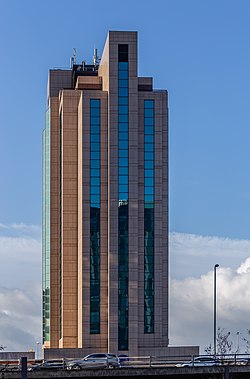Portcullis House, Glasgow
Proposed buildings and structures in ScotlandProposed skyscrapers in the United KingdomSkyscrapers in GlasgowStudent housing
Portcullis House is a proposed 35-storey skyscraper in Glasgow, Scotland. The development was formally submitted to Glasgow City Council in 2021 by Watkin Jones Group, with the original proposals seeking to construct a 33-storey "co-living" development in Glasgow City Centre. New plans submitted in 2023 saw the removal of one of the original proposed towers, and the reduction in size to a 30-storey tower. In December 2023, an updated plan was submitted, proposing a 35-storey building rising to 114m above ground level.Upon completion, Portcullis House would become the tallest habitable building in Scotland.
Excerpt from the Wikipedia article Portcullis House, Glasgow (License: CC BY-SA 3.0, Authors).Portcullis House, Glasgow
Elmbank Street Lane, Glasgow Anderston
Geographical coordinates (GPS) Address Nearby Places Show on map
Geographical coordinates (GPS)
| Latitude | Longitude |
|---|---|
| N 55.863382 ° | E -4.268906 ° |
Address
Elmbank Street Lane
Elmbank Street Lane
G2 4PB Glasgow, Anderston
Scotland, United Kingdom
Open on Google Maps










